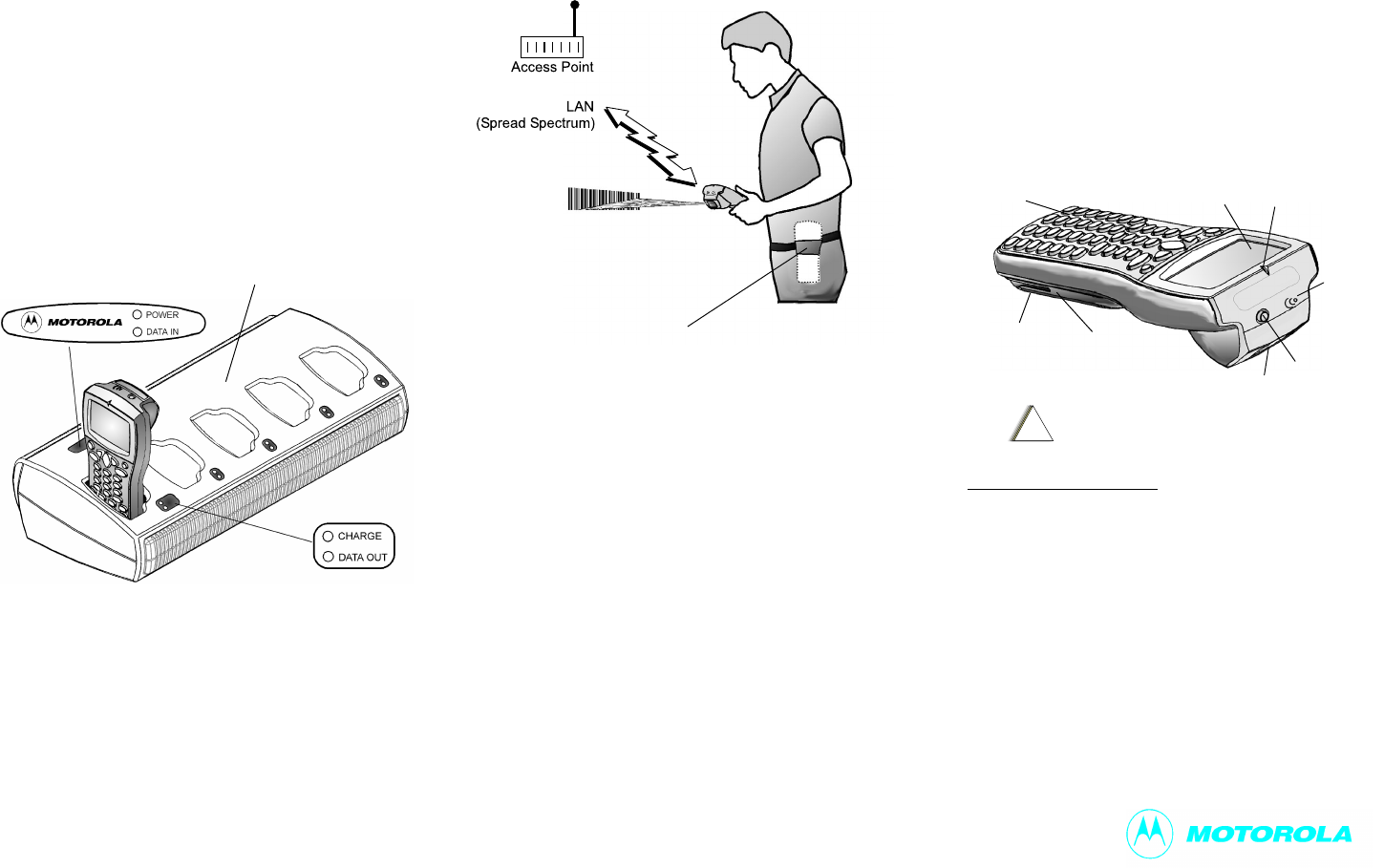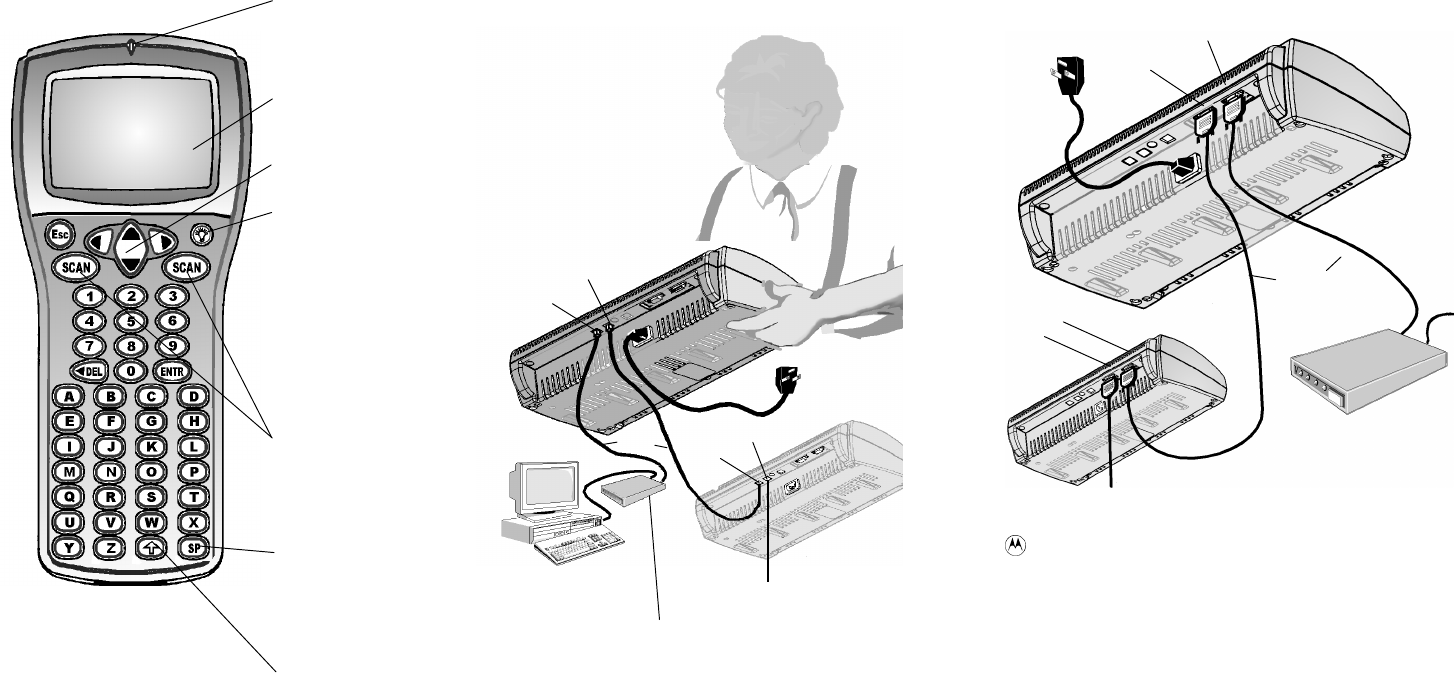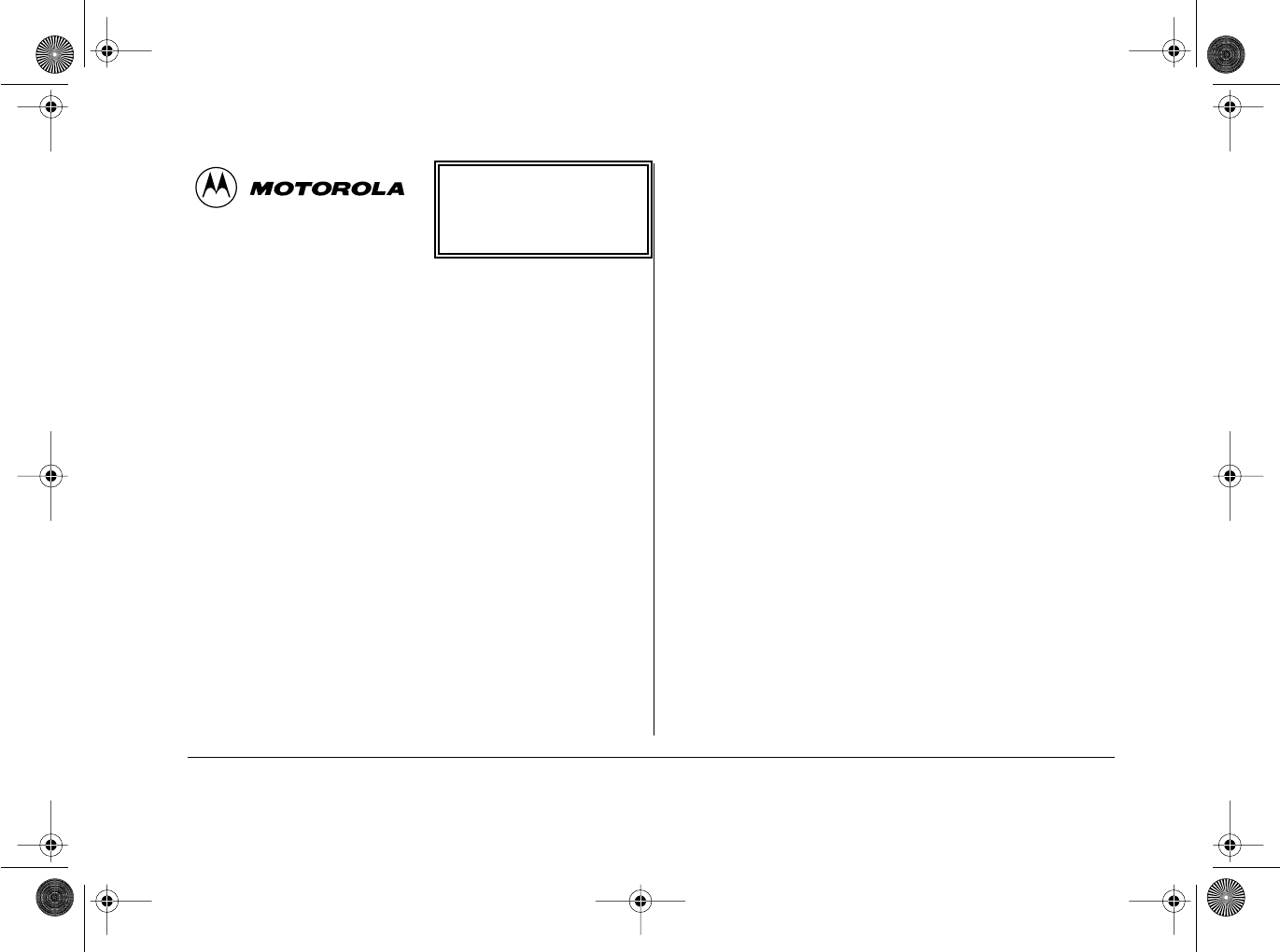Motorola Solutions 92FT7000 User Manual FCC Certification Report for the
Motorola Solutions, Inc. FCC Certification Report for the
Exhibit 8 Instruction Manual HDT401

Applicant: Motorola, Inc. FCC ID:AZ492FT7000
Exhibit 8
VIII. Instruction Manual
1.) Quick Reference Card HDT 400 Series
2.) Safety Warnings - Handheld Data Terminal, HDT Family
Safe and Efficient Operation of Motorola Two Way Radio Products

Battery Charge LED
(see figure below)
• No light - Not in use
• Red light - Battery charging (8 hours for full
capacity)
• Green light - Battery fully charged
Important Note
Battery is considered damaged when charging takes
more than 8 hours. Contact service to replace battery.
Data Communication With Host
(see figure above)
Communication between the HDT 401 and the host
computer can be established when the HDT 401 rests
in the Office Dock. When data flows from the
HDT 401 to the host computer, the Data Out yellow
LED lights.
When data flows from the host computer to the
HDT 401, the Data In yellow LED lights.
Approved Accessories
• FNN6001B: Battery – Lithium Ion 3.6V
1450mAH.
• FLN9202A: Belt Holster – full size with pocket.
• FLN9623A: Belt Holster – slipper.
• FLN9438A: Stylus pen.
• FKN4886A: Serial cable (1m) standard EIA
RS232 DB9.
• FKN4871A: Serial cable (1m) coiled for Camero
printer DIN8.
• FKN4792A: Serial cable (20cm) DB25 with
negative supply pin.
• FKN4793A: Serial cable (1m) DB25 with power
pins.
HDT 401
Hand-held Data Terminal
with Local Area Network Radio Modem
And LASER Barcode Scanner
Quick Reference Card
Switching On
Press the Power On/Off button for more than 2
seconds. The Power Indication Light will illuminate,
indicating that the battery is O.K. and the device is
operative.
Switching Off
Press the Power On/Off button for more than 2
seconds and release. The Power Indication Light will
turn off.
HDT 401 Holster
Office Dock
P
ower On/Off
Button
Keypad Screen
Buzzer
Battery Pack
(Do not remove)
Indication Light
Laser Scanner
Infrared
communication
A
perture
!
C a u t i o n
CAUTION
To avoid possible eye injury, do not stare
d
irectly at the laser beam of the scanner.
Important Care Instructions: Use a soft damp cloth to clean the
infrared communication aperture and laser window.

Front Panel
The HDT 401 Keys are assigned to operate according
to the specific usage of the device. However, the
items shown below refer to basic operations available
in all HDT 401 configurations.
Setting the Office Dock
Local Computer Control
A local computer configuration enables a cascade
connection of up to 31 Office Dock units (155
HDT 401 devices) to one RS-485 port in the host
computer. For connections, see figure below.
Remote Computer Control
A remote computer control configuration enables a
cascade connection of up to 3 Office Dock units (15
HDT 401 devices) to the host computer. A Line
Modem is used for communication with remote
located host computer. For connections, see figure
below.
and Motorola are registered trademarks of Motorola Inc.
©Motorola Inc., 2000 68P02959C84-A
@6802959C84@
To
Phone
Line
J
2
J
1
A
C Power Outlet
Line Modem
(28.8 or 33.6kb/s)
J1
RS-232
To Third Office Dock Unit
J2
To more Office Dock Units
J3
J4
Host Computer
RS-485
c
ables J3
J
4
RS-485 to RS-232 Converter
Navigation Keys
Screen Light
(When pressed with
Shift key, contrast
level increases
cyclically).
IMPORTANT: To
save battery power,
use Screen Light
only when needed.
Barcode Scanner
Keys (for left-hand
and right-hand users)
Screen
Indication Light
(Operation is defined
by configuration)
Shift Key
Space Key
(Operation is defined
by configuration)

68P02960C25-O Safety Warnings
Please retain for future use
Safe and Efficient Operation
of Motorola Two Way Radio Products
RF OPERATIONAL CHARACTERISTICS
Your radio contains a transmitter which transmits using very short bursts of
data;a receiver which receives radio frequency (RF); and an internal antenna.
EXPOSURE TO RADIO FREQUENCY ENERGY
Your Motorola radio product is designed to comply with the following national
and international standards and guidelines regarding exposure of human be-
ings to radio frequency electromagnetic energy:
• United States Federal Communications Commission,
Code of Federal Regulations; 47 CFR part 2 sub-part J
• American National Standards Institute (ANSI) / Institute of Electrical and
Electronic Engineers (IEEE) C 95. 1-1992
• Institute of Electrical and Electronic Engineers (IEEE),
C95.1-1999 Edition
• National Council on Radiation Protection and Measurements (NCRP) of
the United States,
Report 86, 1986
• International Commission on Non-Ionizing Radiation Protection (ICNIRP
(1998)
• National Radiological Protection Board of the United Kingdom, (1995)
• Ministry of Health (Canada) Safety Code 6. Limits of Human Exposure to
Radiofrequency Electromagnetic Fields in the Frequency Range from 3
kHz to 300 GHz, 1999
• Australian Communications Authority Radiocommunications (Electro-
magnetic Radiation - Human Exposure) Standard 1999 (applicable to
wireless phones only).
To assure optimal radio product performance and to make sure human expo-
sure to radio frequency electromagnetic energy is within the guidelines set
forth in the above standards, always adhere to the following procedures:
PORTABLE RADIO PRODUCT OPERATION & EME EXPOSURE
BODY-WORN OPERATION
To maintain compliance with FCC RF exposure guidelines, if you wear a radio
product on your body when transmitting, always place the radio product in a
Motorola supplied or approved clip, holder, holster, case, or body harness.
Use of non-Motorola-approved accessories may exceed FCC RF exposure
guidelines. If you do not use a body-worn accessory, and are not using the
radio product held in the normal use position, ensure the radio product is at
least one inch (2.5 cms) from your body when transmitting
.
APPROVED ACCESSORIES
For a list of approved Motorola accessories, please contact the local autho-
rized Motorola dealer.
ELECTROMAGNETIC INTERFERENCE / COMPATIBILITY
NOTE
: Nearly every electronic device is susceptible to electromagnetic inter-
ference (EMI) if inadequately shielded, designed or otherwise configured for
electromagnetic compatibility
FACILITIES
To avoid electromagnetic interference and/or compatibility conflicts, turn off
your radio product in any facility where posted notices instruct you to do so.
Hospitals or health care facilities may be using equipment that is sensitive to
external RF energy
.
AIRCRAFT
When instructed to do so, turn off your radio product when on board an air-
craft. Any use of a radio product must be in accordance with airline regula-
tions or airline crew instructions.
HANDHELD DATA
TERMINAL
HDT Family
EME Warnings A5 landscapeHTD400 Page 1 Wednesday, October 11, 2000 5:33 PM

MEDICAL DEVICES
Pacemakers
The Health Industry Manufacturers Association recommends that a minimum
separation of 6 inches (15 centimeters) be maintained between a handheld
wireless radio product and a pacemaker.These recommendations are con-
sistent with the independent research by, and recommendations of, Wireless
Technology Research.
Persons with pacemakers should:
1.
ALWAYS keep the radio product more than six inches (15 centimeters)
from their pacemaker when the radio product is turned ON
.
2. Not to carry the radio product in the breast pocket.
3. Use the radio product away from the pacemaker to minimize the poten-
tial for interference.
4. Turn the radio product OFF immediately if you have any reason to sus-
pect that interference is taking place.
Hearing Aids
Some digital wireless radio products may interfere with some hearing aids. In
the event of such interferences you may want to consult your hearing aid
manufacturer to discuss alternatives.
Other Medical Devices
If you use any other personal medical device, consult the manufacturer of
your device to determine if it is adequately shielded from RF energy.Your
physician may be able to assist you in obtaining this information.
Safety and General
Use While Driving
Check the laws and regulations on the use of radio products in the area
where you drive. Always obey them.
When using your radio product while driving, please:
1.
Give full attention to driving and to the road.
2. Use hands-free operation, if available.
3. Pull off the road and park before making or answering a call if driving
conditions so require.
OPERATIONAL WARNINGS
FOR VEHICLES WITH AIR BAG
Do not place a radio prod
uct in the area over an air bag or in the air bag
deployment area. Air bags inflate with great force. If a portable radio product
is placed in the air bag deployment area and the air bag inflates, the radio
product may be propelled with great force and cause serious injury to occu-
pants of the vehicle.
POTENTIALLY EXPLOSIVE ATMOSPHERES
Turn off your two way radio product prior to entering any area with a poten-
tially explosive atmosphere, unless it is a radio product type especially qual-
ified for use in such areas as “Intrinsically Safe” (for example, Factory Mutual,
CSA, or UL Approved). Do not remove, install, or charge batteries in such
areas. Sparks in a potentially explosive atmosphere can cause an explosion
or fire resulting in bodily injury or even death.
NOTE:
The areas with potentially explosive atmospheres referred to above include fueling
areas such as; below decks on boats, fuel or chemical transfer or storage facilities, areas
where the air contains chemicals or particles such as grain, dust, or metal powders;and
any other area where you would normally be advised to turn off your vehicle engine. Areas
with potentially explosive atmospheres are often but not always posted.
BLASTING CAPS AND AREAS
To avoid possible interference with blasting operations, turn off your radio
product when you are near electrical blasting caps, in a "blasting area", or in
areas posted: "turn off two-way radio." Obey all signs and instructions.
All batteries can cause property damage and/or bodily injury such as burns if
a conductive material such as jewelry, keys, or beaded chains touch exposed
terminals. The conductive material may complete an electrical circuit (short
circuit) and become quite hot. Exercise care in handling any charged battery,
particularly when placing it inside a pocket, purse, or other container with
metal objects.
!
C a u t i o n
OPERATIONAL CAUTIONS
BATTERIES
!
W A R N I N G
!
EME Warnings A5 landscapeHTD400 Page 2 Wednesday, October 11, 2000 5:33 PM